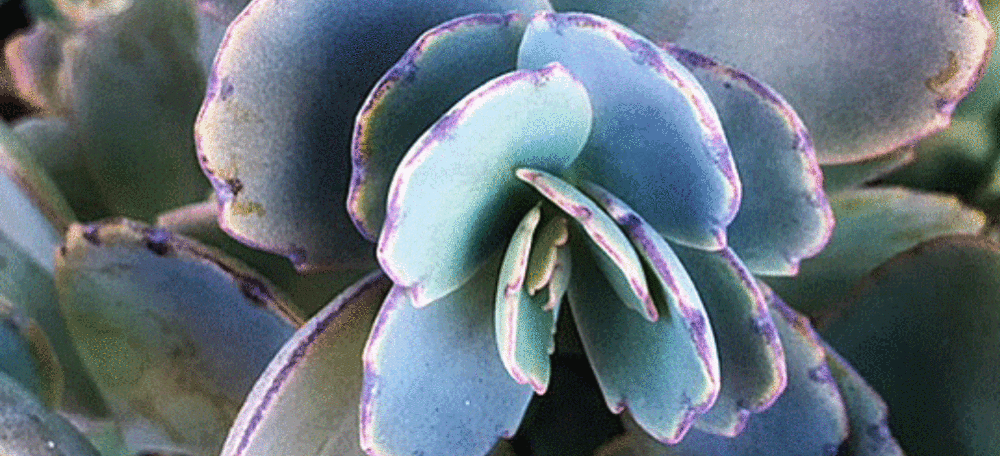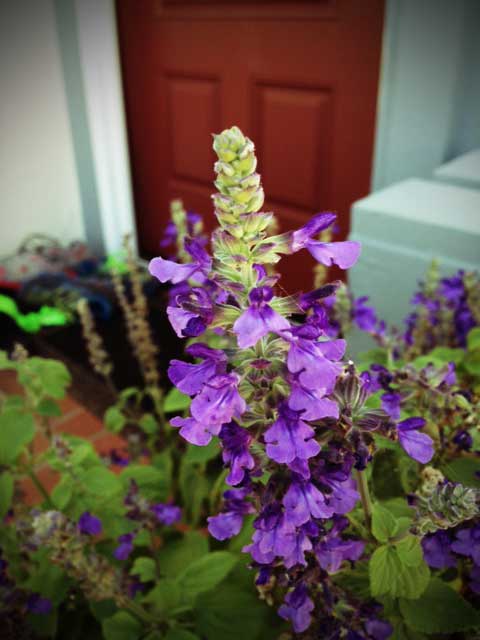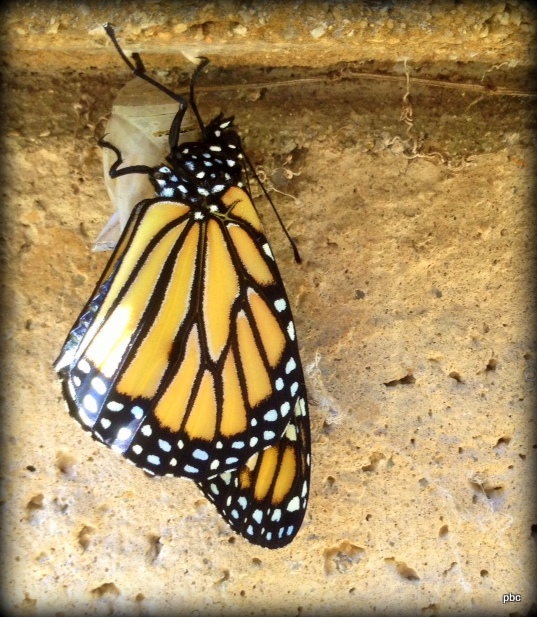In September I wrote about my mandevilla plant that had suffered terribly during an extreme heat wave that occured while we were away on vacation. I’d hoped to be able to return the previously beautiful plant to good health. Unfortunately I wasn’t able to save it, even after careful watering, and relocating it to a less sunny spot in the garden. The direct early morning sun was just too much for it. The plant had looked beautiful near our front door, but now the spot was vacant. I’d recently purchased a Mystic Blue Salvia to add to my hummingbird garden. It was doing well and growing nicely in a large container. I wondered how it would look by the front door in place of the mandevilla. As you can see in the photo above the Mystic Blue is doing very well in its new place and looks even prettier than the mandevilla. It is fuller and fills the area beautifully.
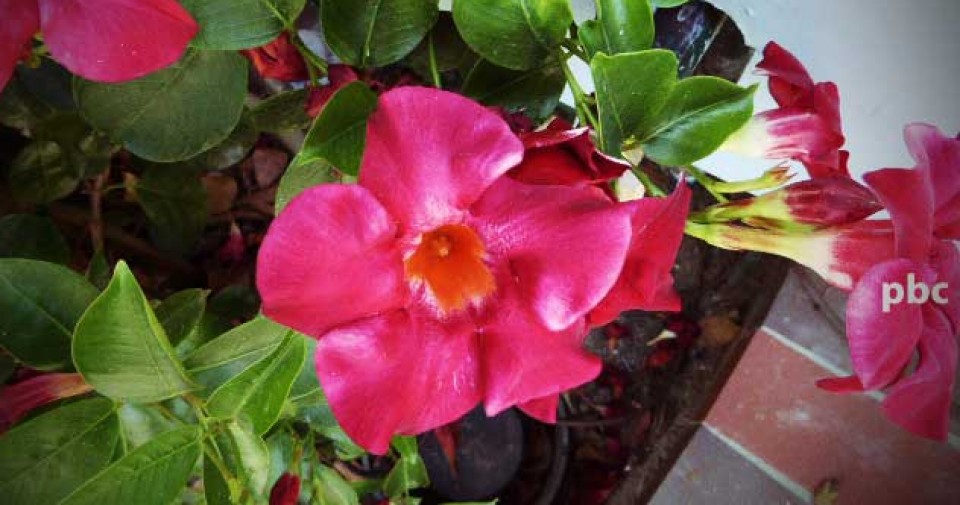 Here you see the mandevilla before our vacation. Both are lovely plants, but the salvia is a better choice for the spot. Most salvia prefer full sun, so will do better in our front garden, especially in the summer. I was very sorry to lose my beautiful pink mandevilla, but I’m very happy with the end result.
Here you see the mandevilla before our vacation. Both are lovely plants, but the salvia is a better choice for the spot. Most salvia prefer full sun, so will do better in our front garden, especially in the summer. I was very sorry to lose my beautiful pink mandevilla, but I’m very happy with the end result.
Tag Archives: garden
Finding My Niche
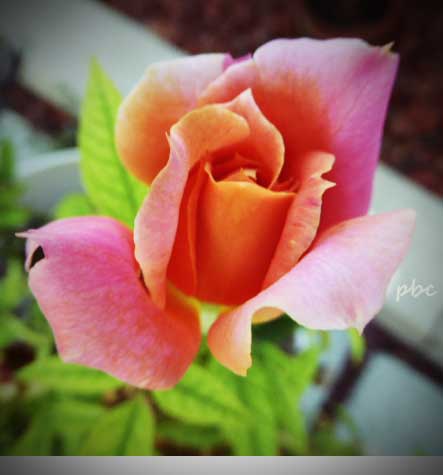 Today my niche is gardening and photography. This is a photo of my Disneyland florabunda rose bush.
Today my niche is gardening and photography. This is a photo of my Disneyland florabunda rose bush.
I’ve been publishing my blog for a little over a year and I’ve yet to find my niche. I’m always reading one article or another on blogging, and one of the things they say you must do, is find your niche. If you browse my previous posts, you’ll see that I have many interests, including gardening, knitting, watercolor painting, cooking, ceramics, walking and cycling. Not to mention riding my can-am spyder, traveling in our 5th wheel trailer, and writing about it all, at one time or another. One thing I always try to include in my blog is lively colors, and photos that make you feel better having seen them.
 Here is one of my very special interests. Our little ShihTzu Fox Terrier mix, Annika. I took this photo soon after returning home from our four days of camping in Chula Vista. Lots of fresh air and exercise tired her out. She was happy to be home and snuggled in her favorite chair catching up on her sleep. Perhaps digital photography is my niche. Well, at least for today, but who knows what tomorrow will bring.
Here is one of my very special interests. Our little ShihTzu Fox Terrier mix, Annika. I took this photo soon after returning home from our four days of camping in Chula Vista. Lots of fresh air and exercise tired her out. She was happy to be home and snuggled in her favorite chair catching up on her sleep. Perhaps digital photography is my niche. Well, at least for today, but who knows what tomorrow will bring.
Magic Lantern Hybrid Tea Rose
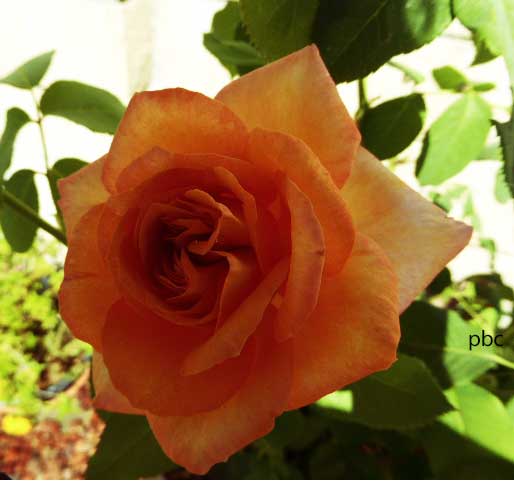 Our Weather has been very hot lately, and I haven’t spent a lot of time outside. This morning when I went out to look at the front garden, I was thrilled to see my Magic Lantern Hybrid tea rose in bloom. It is such a beautiful coppery orange color. Hybrid teas are the most popular type of rose. Not only is the blossom gorgeous, but as you can see below, the bud is also a joy to look at.
Our Weather has been very hot lately, and I haven’t spent a lot of time outside. This morning when I went out to look at the front garden, I was thrilled to see my Magic Lantern Hybrid tea rose in bloom. It is such a beautiful coppery orange color. Hybrid teas are the most popular type of rose. Not only is the blossom gorgeous, but as you can see below, the bud is also a joy to look at.
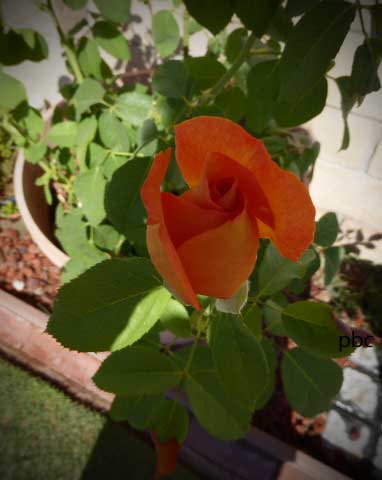 Hybrid tea roses usually produce one bloom on a long stem, which makes them perfect for cut flower displays. Hybrid teas are also popular because they continue to produce flowers all season long. My Magic Lantern has a light fragrance, although many tea roses have a much stronger scent. Magic Lantern is a very vigorous variety and is easy to care for. This plant is now in a large pot at the front of our house. It gets morning sun and seems very happy there. It does like frequent watering. I originally planted the Magic Lantern in the lawn at the side of our house. Three summers ago, a guest, when leaving, backed over the plant and flattened it, splitting the main stem. I dug up the bush and transplanted it to the pot it now grows in. I thought it was the end of my beautiful Magic Lantern, but as you can see, it not only survived, but has thrived. Now you know why I say it’s a hearty variety, and I’m especially fond of our Magic Lantern Hybrid Tea Rose. You might want to add one to your garden.
Hybrid tea roses usually produce one bloom on a long stem, which makes them perfect for cut flower displays. Hybrid teas are also popular because they continue to produce flowers all season long. My Magic Lantern has a light fragrance, although many tea roses have a much stronger scent. Magic Lantern is a very vigorous variety and is easy to care for. This plant is now in a large pot at the front of our house. It gets morning sun and seems very happy there. It does like frequent watering. I originally planted the Magic Lantern in the lawn at the side of our house. Three summers ago, a guest, when leaving, backed over the plant and flattened it, splitting the main stem. I dug up the bush and transplanted it to the pot it now grows in. I thought it was the end of my beautiful Magic Lantern, but as you can see, it not only survived, but has thrived. Now you know why I say it’s a hearty variety, and I’m especially fond of our Magic Lantern Hybrid Tea Rose. You might want to add one to your garden.
Hummingbirds and Hooded Orioles
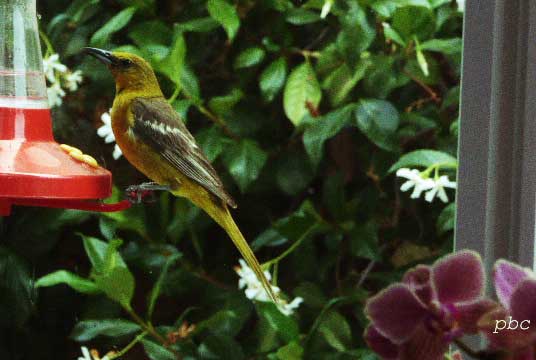 This is the female Hooded Oriole that visits the hummingbird feeder outside our kitchen window every day and dines on the hummingbird food. Continue reading
This is the female Hooded Oriole that visits the hummingbird feeder outside our kitchen window every day and dines on the hummingbird food. Continue reading
Get Ready Now for the Monarch Butterfly
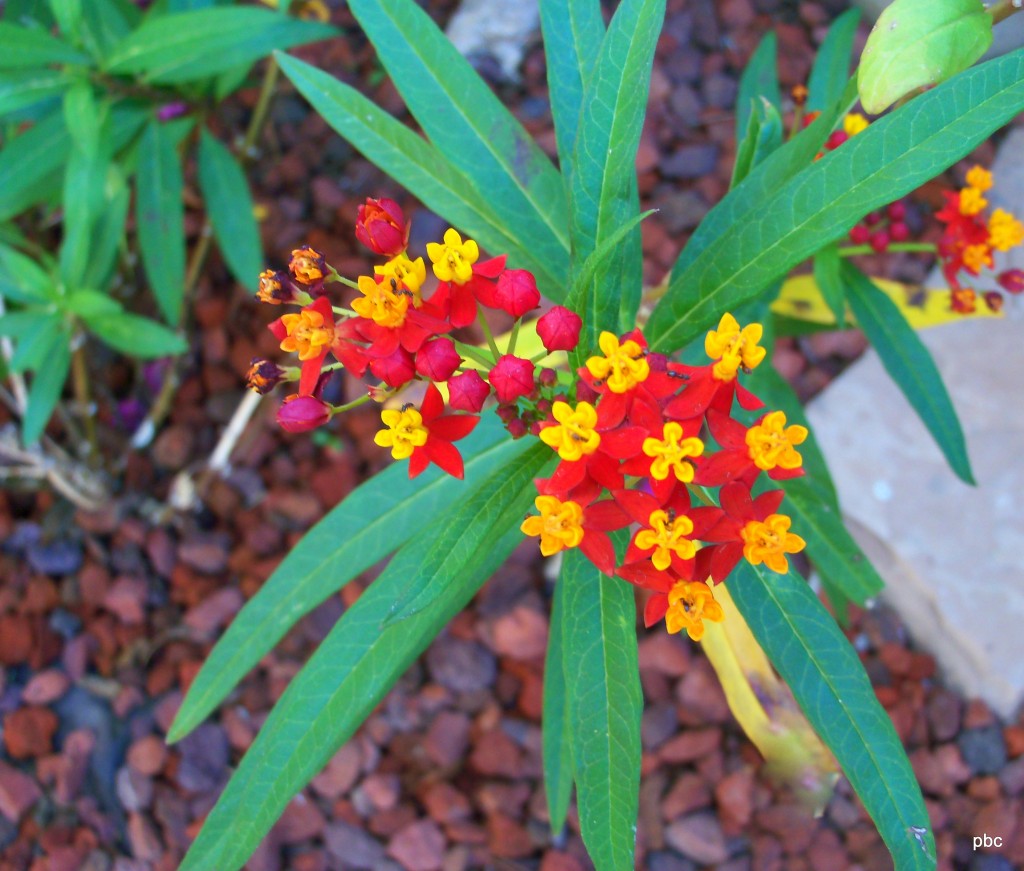
The Monarch Butterfly is beautiful, and easy to attract to your garden. Milkweed is the Monarch’s favorite food. Our milk weed plants are finally recovering now that the Monarch butterfly season is over for us. This was our second year with the Monarchs, and right now I am watering and feeding the plants in preparation for spring. Last year, as the caterpillars devoured our plants, and adult Monarchs continued to lay eggs, we purchased several additional milk week plants. We quickly realized that this was becoming an endless cycle, so eventually stopped buying plants and let the adult monarchs look elsewhere to lay their eggs. 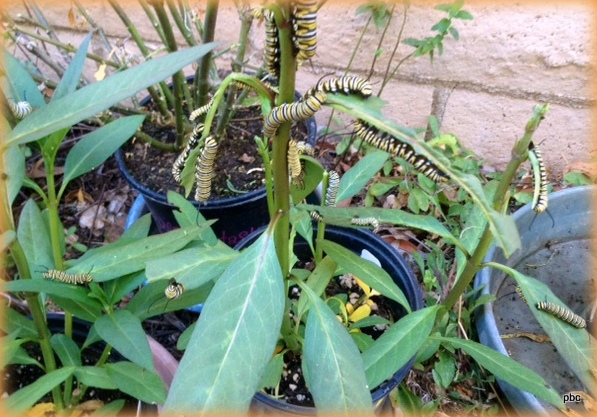
Here you see the monarch caterpillars munching on Milk Weed in our garden. The caterpillar stage lasts anywhere from 9 to 14 days and eventually the plants will become bare stems with roots. It is remarkable how these plants recover once the Monarch butterflies have flown from our area.
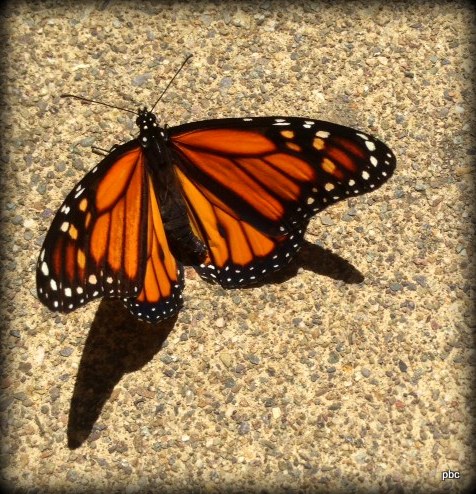
These photos were all taken in our back yard, and if you would like to know more about the Monarch butterfly, please go to Monarch-Butterfly.com . They do a wonderful job of telling the full story of the truly awesome Monarch Butterfly.
